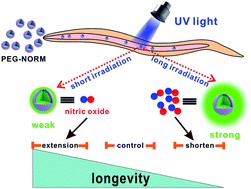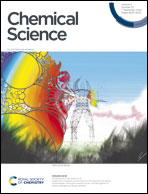Modulation of the lifespan of C. elegans by the controlled release of nitric oxide†
Abstract
The frontier of nitric oxide biology has gradually shifted from mechanism elucidation to biomanipulation, e.g. cell-proliferation promotion, cell-apoptosis induction, and lifespan modulation. This warrants biocompatible nitric oxide (NO) donating materials, whose NO release is not only controlled by a bioorthogonal trigger, but also self-calibrated allowing real-time monitoring and hence an onset/offset of the NO release. Additionally, the dose of NO release should be facilely adjusted in a large dynamic range; flux and the dose are critical to the biological outcome of NO treatment. Via self-assembly of a PEGylated small-molecule NO donor, we developed novel NO-donating nanoparticles (PEG-NORM), which meet all the aforementioned criteria. We showcased that a low flux of NO induced cell proliferation, while a high flux induced cell oxidative stress and, ultimately, death. Notably, PEG-NORM was capable of efficiently modulating the lifespan of C. elegans. The average lifespan of C. elegans could be fine-tuned to be as short as 15.87 ± 0.29 days with a high dose of NO, or as long as 21.13 ± 0.41 days with a low dose of NO, compared to an average life-span of 18.87 ± 0.46 days. Thus, PEG-NORM has broad potential in cell manipulation and life-span modulation and could drive the advancement of NO biology and medicine.



 Please wait while we load your content...
Please wait while we load your content...